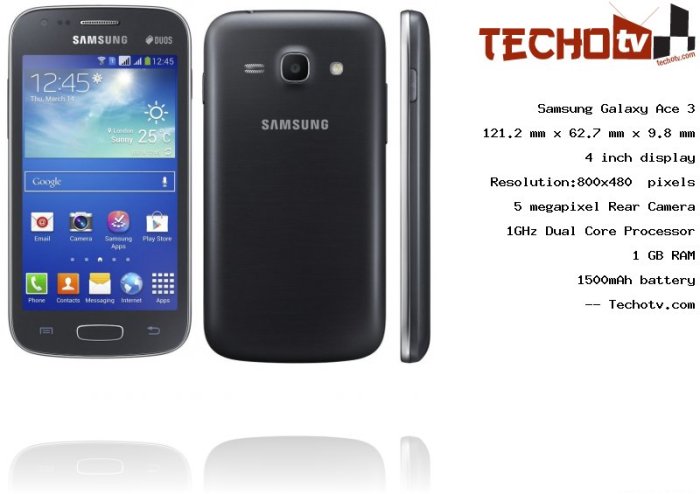Samsung Galaxy Ace 3 Full Specification
Samsung Galaxy Ace 3: A Detailed Overview
Samsung galaxy ace 3 full specification – The Samsung Galaxy Ace 3, a budget-friendly smartphone released in 2013, aimed to provide accessible technology to a wider market. Its marketing emphasized affordability, ease of use, and essential features for everyday tasks. While not a flagship device, it held a significant place in Samsung’s lineup, catering to consumers seeking a reliable and functional phone without a premium price tag.
Device Overview
The Samsung Galaxy Ace 3 was a mid-range Android smartphone launched by Samsung in 2013. It was positioned as an entry-level to mid-range device, offering a balance of features and affordability. Key selling points included its compact size, user-friendly interface, and long battery life. The marketing focused on its suitability for everyday tasks such as communication, social media, and basic web browsing.
- Compact and lightweight design
- Long-lasting battery
- User-friendly interface
- Affordable price point
- Dual-SIM capability (in some regions)
Technical Specifications
The Galaxy Ace 3’s technical specifications reflected its budget-friendly nature. The processor, while functional, had limitations compared to higher-end devices. Its RAM, while modest for its time, was typical for budget smartphones of that era. Internal storage was limited, highlighting the need for external storage solutions such as microSD cards.
| Feature | Specification | Unit | Notes |
|---|---|---|---|
| Processor | 1.2 GHz dual-core | – | Limited processing power compared to contemporary high-end devices. |
| RAM | 1 GB | GB | Comparable to other budget smartphones in 2013, but limited multitasking capabilities. |
| Internal Storage | 4 GB | GB | Expandable via microSD card, necessary due to limited internal space. |
| Operating System | Android 4.2 (Jelly Bean) | – | Upgradable to 4.4 (KitKat) in some regions. |
| Display | 4.0 inches, WVGA (480 x 800 pixels) | inches, pixels | Low resolution compared to modern standards. |
| Battery | 1500 mAh | mAh | Provided decent battery life for basic usage. |
Display and Design
The Galaxy Ace 3 featured a 4.0-inch WVGA (480 x 800 pixels) display, resulting in a pixel density of approximately 233 ppi. This was a typical LCD display, offering decent visibility in well-lit conditions but lacking the vibrancy of AMOLED screens. The phone’s design was compact and relatively simple, aligning with Samsung’s design language of the time.
It shared similarities in build quality and material choices with other budget Samsung phones of the era.
Camera Capabilities
The Galaxy Ace 3 included a 5-megapixel rear camera with autofocus and a VGA front-facing camera. While not exceptional, the cameras were adequate for casual photography and video recording at that time. Image quality was reasonable in good lighting conditions, but struggled in low light. Video quality was acceptable for basic recording. Compared to other phones in its price range, the camera performance was relatively average.
Software and User Experience, Samsung galaxy ace 3 full specification
The Samsung Galaxy Ace 3 initially shipped with Android 4.2 (Jelly Bean). The user interface was a relatively standard Samsung TouchWiz experience, providing a familiar and easy-to-navigate layout. Pre-installed applications included a suite of Samsung apps, along with standard Google applications. User reviews generally described the user experience as smooth and responsive for everyday tasks, though the older hardware limitations became apparent with more demanding applications.
Battery Life and Performance

Source: techotv.com
The device incorporated a 1500 mAh battery. Battery life varied depending on usage, but generally provided a full day of use with moderate usage. Performance was acceptable for basic tasks like browsing, messaging, and calling. However, more demanding applications or heavy multitasking could lead to some slowdown. Compared to other similarly priced devices, battery life was considered quite good.
Connectivity and Features

Source: turbosquid.com
The Galaxy Ace 3 offered a range of connectivity options, including Wi-Fi, Bluetooth, and cellular data support (depending on the region and carrier). Notable features included dual-SIM support in certain models. The phone included a variety of sensors common in smartphones of the time.
- Accelerometer
- Proximity sensor
- GPS
- Wi-Fi 802.11 b/g/n
- Bluetooth 4.0
Legacy and Impact
The Samsung Galaxy Ace 3 enjoyed moderate success in the market, proving popular among budget-conscious consumers. While not a groundbreaking device, it played a role in expanding access to smartphones. It was succeeded by several models in the Ace series, each building upon its features and addressing some of its limitations. The Galaxy Ace 3’s impact lies in its contribution to Samsung’s broad smartphone portfolio, providing a functional and affordable option for a significant segment of the market.
Essential Questionnaire: Samsung Galaxy Ace 3 Full Specification
Was the Samsung Galaxy Ace 3 waterproof?
No, the Samsung Galaxy Ace 3 was not waterproof.
Did the Samsung Galaxy Ace 3 have expandable storage?
Yes, it typically offered microSD card support for expandable storage.
What was the typical battery life of the Samsung Galaxy Ace 3?
Battery life varied depending on usage, but generally provided a full day of moderate use.
What were some common complaints about the Samsung Galaxy Ace 3?
Common complaints included occasional performance lag and a relatively low-resolution display.





















